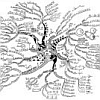|
|
|
|
|
|
|
|
| |
  
Gabriel Cardona,
Joan Carles Pons and
Francesc Rosselló. A reconstruction problem for a class of phylogenetic networks with lateral gene transfers. In ALMOB, Vol. 10(28):1-15, 2015.
Keywords: explicit network, from rooted trees, lateral gene transfer, phylogenetic network, phylogeny, Program LGTnetwork, reconstruction, software, tree-based network.
Note: http://dx.doi.org/10.1186/s13015-015-0059-z.
|
|
|
|
|
|
| |
   
Gabriel Cardona,
Mercè Llabrés,
Francesc Rosselló and
Gabriel Valiente. The comparison of tree-sibling time consistent phylogenetic networks is graph-isomorphism complete. In The Scientific World Journal, Vol. 2014(254279):1-6, 2014.
Keywords: abstract network, distance between networks, from network, isomorphism, phylogenetic network, tree sibling network.
Note: http://arxiv.org/abs/0902.4640.
Toggle abstract
"Several polynomial time computable metrics on the class of semibinary tree-sibling time consistent phylogenetic networks are available in the literature; in particular, the problem of deciding if two networks of this kind are isomorphic is in P. In this paper, we show that if we remove the semibinarity condition, then the problem becomes much harder. More precisely, we prove that the isomorphism problem for generic tree-sibling time consistent phylogenetic networks is polynomially equivalent to the graph isomorphism problem. Since the latter is believed not to belong to P, the chances are that it is impossible to define a metric on the class of all tree-sibling time consistent phylogenetic networks that can be computed in polynomial time. © 2014 Gabriel Cardona et al."
|
|
| |
   
Adrià Alcalà Mena,
Mercè Llabrés,
Francesc Rosselló and
Pau Rullan. Tree-Child Cluster Networks. In Fundamenta Informaticae, Vol. 134(1-2):1-15, 2014.
Keywords: explicit network, from clusters, phylogenetic network, phylogeny, Program PhyloNetwork, reconstruction, tree-child network.
|
|
|
|
|
|
|
|
|
|
| |
   
Gabriel Cardona,
Mercè Llabrés,
Francesc Rosselló and
Gabriel Valiente. Comparison of Galled Trees. In TCBB, Vol. 8(2):410-427, 2011.
Note: http://arxiv.org/abs/0906.1166.
Toggle abstract
"Galled trees, directed acyclic graphs that model evolutionary histories with isolated hybridization events, have become very popular due to both their biological significance and the existence of polynomial-time algorithms for their reconstruction. In this paper, we establish to which extent several distance measures for the comparison of evolutionary networks are metrics for galled trees, and hence, when they can be safely used to evaluate galled tree reconstruction methods. © 2011 IEEE."
|
|
|
|
|
|
| |
   
Gabriel Cardona,
Mercè Llabrés,
Francesc Rosselló and
Gabriel Valiente. Path lengths in tree-child time consistent hybridization networks. In Information Sciences, Vol. 180(3):366-383, 2010.
Keywords: distance between networks, phylogenetic network, phylogeny, time consistent network, tree-child network.
Note: http://arxiv.org/abs/0807.0087?context=cs.CE.
Toggle abstract
"Hybridization networks are representations of evolutionary histories that allow for the inclusion of reticulate events like recombinations, hybridizations, or lateral gene transfers. The recent growth in the number of hybridization network reconstruction algorithms has led to an increasing interest in the definition of metrics for their comparison that can be used to assess the accuracy or robustness of these methods. In this paper we establish some basic results that make it possible the generalization to tree-child time consistent (TCTC) hybridization networks of some of the oldest known metrics for phylogenetic trees: those based on the comparison of the vectors of path lengths between leaves. More specifically, we associate to each hybridization network a suitably defined vector of 'splitted' path lengths between its leaves, and we prove that if two TCTC hybridization networks have the same such vectors, then they must be isomorphic. Thus, comparing these vectors by means of a metric for real-valued vectors defines a metric for TCTC hybridization networks. We also consider the case of fully resolved hybridization networks, where we prove that simpler, 'non-splitted' vectors can be used. © 2009 Elsevier Inc. All rights reserved."
|
|
| |
|
| |
|
|
|
|
|
| |
  
Gabriel Cardona,
Francesc Rosselló and
Gabriel Valiente. Comparison of tree-child phylogenetic networks. In TCBB, Vol. 6(4):552-569, 2009.
Keywords: explicit network, phylogenetic network, phylogeny, Program Bio PhyloNetwork, Program PhyloNetwork, tree sibling network, tree-child network.
Note: http://arxiv.org/abs/0708.3499.
Toggle abstract
"Phylogenetic networks are a generalization of phylogenetic trees that allow for the representation of nontreelike evolutionary events, like recombination, hybridization, or lateral gene transfer. While much progress has been made to find practical algorithms for reconstructing a phylogenetic network from a set of sequences, all attempts to endorse a class of phylogenetic networks (strictly extending the class of phylogenetic trees) with a well-founded distance measure have, to the best of our knowledge and with the only exception of the bipartition distance on regular networks, failed so far. In this paper, we present and study a new meaningful class of phylogenetic networks, called tree-child phylogenetic networks, and we provide an injective representation of these networks as multisets of vectors of natural numbers, their path multiplicity vectors. We then use this representation to define a distance on this class that extends the well-known Robinson-Foulds distance for phylogenetic trees and to give an alignment method for pairs of networks in this class. Simple polynomial algorithms for reconstructing a tree-child phylogenetic network from its path multiplicity vectors, for computing the distance between two tree-child phylogenetic networks and for aligning a pair of tree-child phylogenetic networks, are provided. They have been implemented as a Perl package and a Java applet, which can be found at http://bioinfo.uib.es/~recerca/ phylonetworks/mudistance/. © 2009 IEEE."
|
|
| |
   
Gabriel Cardona,
Mercè Llabrés,
Francesc Rosselló and
Gabriel Valiente. Metrics for phylogenetic networks I: Generalizations of the Robinson-Foulds metric. In TCBB, Vol. 6(1):46-61, 2009.
Keywords: distance between networks, explicit network, phylogenetic network, phylogeny, time consistent network, tree-child network, tripartition distance.
Note: http://dx.doi.org/10.1109/TCBB.2008.70.
Toggle abstract
"The assessment of phylogenetic network reconstruction methods requires the ability to compare phylogenetic networks. This is the first in a series of papers devoted to the analysis and comparison of metrics for tree-child time consistent phylogenetic networks on the same set of taxa. In this paper, we study three metrics that have already been introduced in the literature: the Robinson-Foulds distance, the tripartitions distance and the $mu$-distance. They generalize to networks the classical Robinson-Foulds or partition distance for phylogenetic trees. We analyze the behavior of these metrics by studying their least and largest values and when they achieve them. As a by-product of this study, we obtain tight bounds on the size of a tree-child time consistent phylogenetic network. © 2006 IEEE."
|
|
| |
   
Gabriel Cardona,
Mercè Llabrés,
Francesc Rosselló and
Gabriel Valiente. Metrics for phylogenetic networks II: Nodal and triplets metrics. In TCBB, Vol. 6(3):454-469, 2009.
Keywords: distance between networks, phylogenetic network, phylogeny.
Note: http://dx.doi.org/10.1109/TCBB.2008.127.
Toggle abstract
"The assessment of phylogenetic network reconstruction methods requires the ability to compare phylogenetic networks. This is the second in a series of papers devoted to the analysis and comparison of metrics for tree-child time consistent phylogenetic networks on the same set of taxa. In this paper, we generalize to phylogenetic networks two metrics that have already been introduced in the literature for phylogenetic trees: the nodal distance and the triplets distance. We prove that they are metrics on any class of tree- child time consistent phylogenetic networks on the same set of taxa, as well as some basic properties for them. To prove these results, we introduce a reduction/expansion procedure that can be used not only to establish properties of tree-child time consistent phylogenetic networks by induction, but also to generate all tree-child time consistent phylogenetic networks with a given number of leaves. © 2009 IEEE."
|
|
| |
   
Gabriel Cardona,
Mercè Llabrés,
Francesc Rosselló and
Gabriel Valiente. On Nakhleh's metric for reduced phylogenetic networks. In TCBB, Vol. 6(4):629-638, 2009.
Keywords: distance between networks, phylogenetic network, phylogeny.
Note: Preliminary versions: http://arxiv.org/abs/0809.0110 and http://arxiv.org/abs/0801.2354v1.
Toggle abstract
"We prove that Nakhleh's metric for reduced phylogenetic networks is also a metric on the classes of tree-child phylogenetic networks, semibinary tree-sibling time consistent phylogenetic networks, and multilabeled phylogenetic trees. We also prove that it separates distinguishable phylogenetic networks. In this way, it becomes the strongest dissimilarity measure for phylogenetic networks available so far. Furthermore, we propose a generalization of that metric that separates arbitrary phylogenetic networks. © 2009 IEEE."
|
|
| |
 
Francesc Rosselló and
Gabriel Valiente. All that Glisters is not Galled. In MBIO, Vol. 221(1):54-59, 2009.
Keywords: galled tree, phylogenetic network, phylogeny.
Note: http://arxiv.org/abs/0904.2448.
Toggle abstract
"Galled trees, evolutionary networks with isolated reticulation cycles, have appeared under several slightly different definitions in the literature. In this paper, we establish the actual relationships between the main four such alternative definitions: namely, the original galled trees, level-1 networks, nested networks with nesting depth 1, and evolutionary networks with arc-disjoint reticulation cycles. © 2009 Elsevier Inc. All rights reserved."
|
|
|
|
|
|
| |
  
Gabriel Cardona,
Francesc Rosselló and
Gabriel Valiente. Tripartitions do not always discriminate phylogenetic networks. In MBIO, Vol. 211(2):356-370, 2008.
Keywords: distance between networks, phylogenetic network, phylogeny, Program Bio PhyloNetwork, tree-child network, tripartition distance.
Note: http://arxiv.org/abs/0707.2376, slides available at http://www.newton.cam.ac.uk/webseminars/pg+ws/2007/plg/plgw01/0904/valiente/.
Toggle abstract
"Phylogenetic networks are a generalization of phylogenetic trees that allow for the representation of non-treelike evolutionary events, like recombination, hybridization, or lateral gene transfer. In a recent series of papers devoted to the study of reconstructibility of phylogenetic networks, Moret, Nakhleh, Warnow and collaborators introduced the so-called tripartition metric for phylogenetic networks. In this paper we show that, in fact, this tripartition metric does not satisfy the separation axiom of distances (zero distance means isomorphism, or, in a more relaxed version, zero distance means indistinguishability in some specific sense) in any of the subclasses of phylogenetic networks where it is claimed to do so. We also present a subclass of phylogenetic networks whose members can be singled out by means of their sets of tripartitions (or even clusters), and hence where the latter can be used to define a meaningful metric. © 2007 Elsevier Inc. All rights reserved."
|
|
| |
  
Gabriel Cardona,
Francesc Rosselló and
Gabriel Valiente. A Perl Package and an Alignment Tool for Phylogenetic Networks. In BMCB, Vol. 9:175, 2008.
Keywords: distance between networks, phylogenetic network, phylogeny, Program Bio PhyloNetwork, tree sibling network, tree-child network.
Note: http://dx.doi.org/10.1186/1471-2105-9-175.
Toggle abstract
"Background: Phylogenetic networks are a generalization of phylogenetic trees that allow for the representation of evolutionary events acting at the population level, like recombination between genes, hybridization between lineages, and lateral gene transfer. While most phylogenetics tools implement a wide range of algorithms on phylogenetic trees, there exist only a few applications to work with phylogenetic networks, none of which are open-source libraries, and they do not allow for the comparative analysis of phylogenetic networks by computing distances between them or aligning them. Results: In order to improve this situation, we have developed a Perl package that relies on the BioPerl bundle and implements many algorithms on phylogenetic networks. We have also developed a Java applet that makes use of the aforementioned Perl package and allows the user to make simple experiments with phylogenetic networks without having to develop a program or Perl script by him or herself. Conclusion: The Perl package is available as part of the BioPerl bundle, and can also be downloaded. A web-based application is also available (see availability and requirements). The Perl package includes full documentation of all its features. © 2008 Cardona et al; licensee BioMed Central Ltd."
|
|
| |
   
Gabriel Cardona,
Mercè Llabrés,
Francesc Rosselló and
Gabriel Valiente. A Distance Metric for a Class of Tree-Sibling Phylogenetic Networks. In BIO, Vol. 24(13):1481-1488, 2008.
Keywords: distance between networks, phylogenetic network, phylogeny, polynomial, tree sibling network.
Note: http://dx.doi.org/10.1093/bioinformatics/btn231.
Toggle abstract
"Motivation: The presence of reticulate evolutionary events in phylogenies turn phylogenetic trees into phylogenetic networks. These events imply in particular that there may exist multiple evolutionary paths from a non-extant species to an extant one, and this multiplicity makes the comparison of phylogenetic networks much more difficult than the comparison of phylogenetic trees. In fact, all attempts to define a sound distance measure on the class of all phylogenetic networks have failed so far. Thus, the only practical solutions have been either the use of rough estimates of similarity (based on comparison of the trees embedded in the networks), or narrowing the class of phylogenetic networks to a certain class where such a distance is known and can be efficiently computed. The first approach has the problem that one may identify two networks as equivalent, when they are not; the second one has the drawback that there may not exist algorithms to reconstruct such networks from biological sequences. Results: We present in this articlea distance measure on the class of semi-binary tree-sibling time consistent phylogenetic networks, which generalize tree-child time consistent phylogenetic networks, and thus also galled-trees. The practical interest of this distance measure is 2-fold: it can be computed in polynomial time by means of simple algorithms, and there also exist polynomial-time algorithms for reconstructing networks of this class from DNA sequence data. © 2008 The Author(s)."
|
|
| |
   
Gabriel Cardona,
Mercè Llabrés,
Francesc Rosselló and
Gabriel Valiente. Phylogenetic Networks: Justification, Models, Distances and Algorithms. In VI Jornadas de Matemática Discreta y Algorítmica (JMDA'08), 2008.
Keywords: distance between networks, mu distance, phylogenetic network, phylogeny, polynomial, survey, time consistent network, tree-child network, tripartition distance, triplet distance.
Note: http://bioinfo.uib.es/media/uploaded/jmda2008_submission_61-1.pdf.
|
|
| |
  
Gabriel Cardona,
Francesc Rosselló and
Gabriel Valiente. Extended Newick: It is Time for a Standard Representation. In BMCB, Vol. 9:532, 2008.
Keywords: evaluation, explicit network, phylogenetic network, Program Bio PhyloNetwork, Program Dendroscope, Program NetGen, Program PhyloNet, Program SplitsTree, Program TCS, visualization.
Note: http://bioinfo.uib.es/media/uploaded/bmc-2008-enewick-sub.pdf.
|
|
|
|
 - forked on GitHub.
- forked on GitHub.





